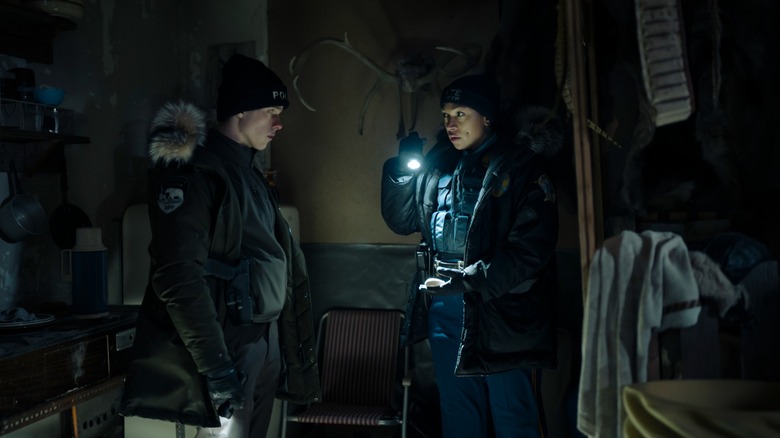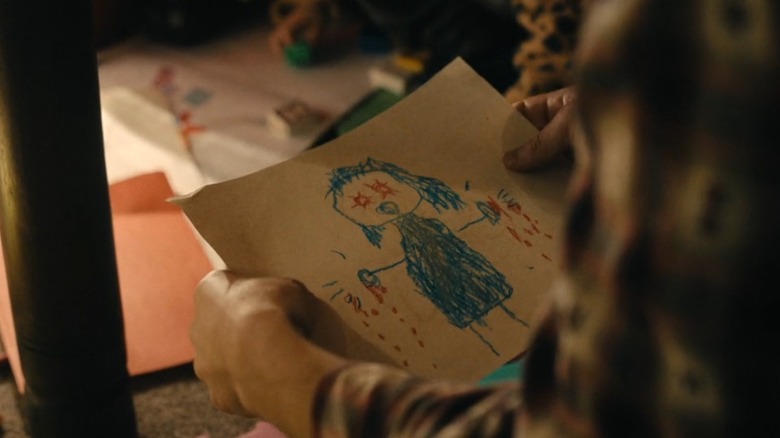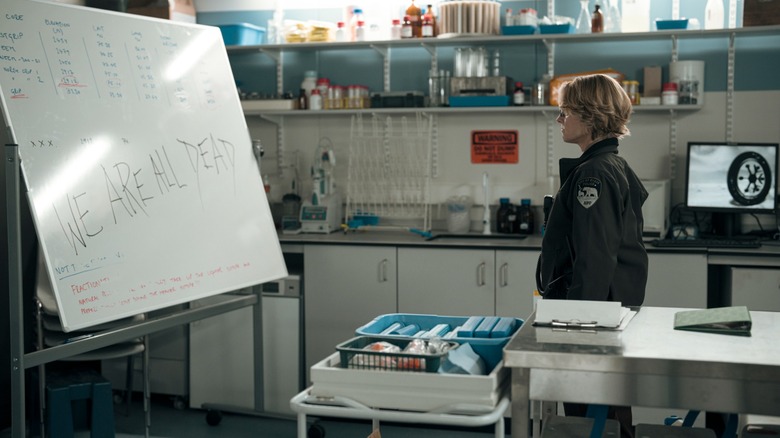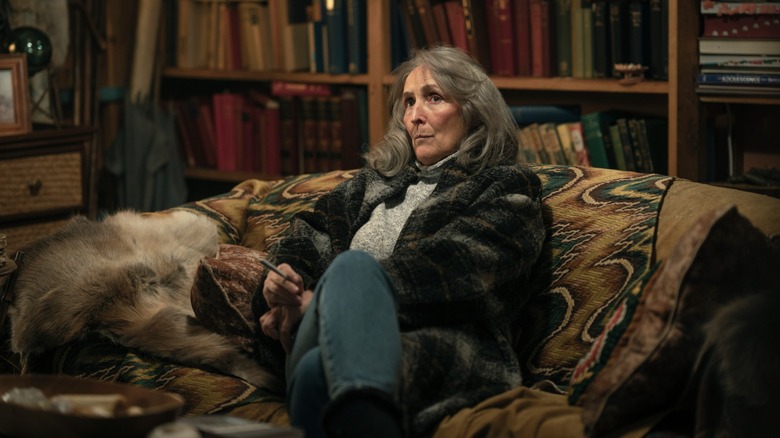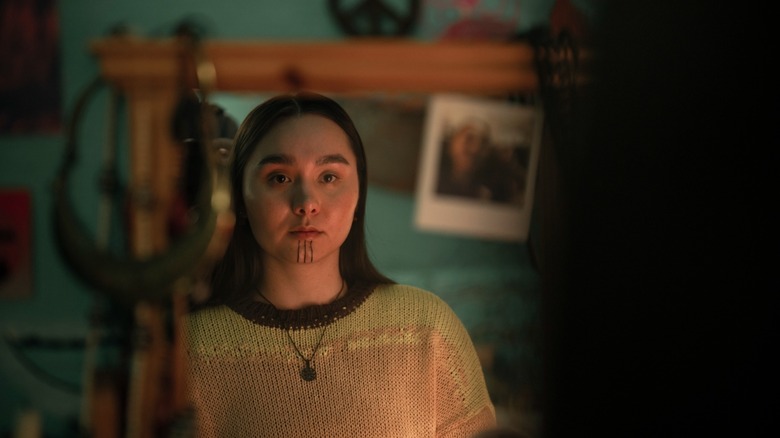Here's Every Major Theory About What's Really Going On In True Detective: Night Country
This post contains spoilers for "True Detective: Night Country."
It's official: we're in the Night Country now. All season, "True Detective: Night Country" has been taking viewers on a scary thrill ride through the frozen heart of a small Alaska town, but the latest episode kicked everything into an almost unbearable high gear — and finally said the show's title in the creepiest context possible. While Navarro (Kali Reis) is left grieving, haunted, and possibly disabled, Danvers (Jodie Foster) sinks lower into her own cycle of self-destruction, and both women face a type of evil that evades easy explanation.
"True Detective: Night Country" is juggling an impressive number of themes, clues, and intersecting plot points, clicking each facet of its multi-genre story together with a satisfying snap as it goes. The series feels like an expertly crafted high-wire act that manages to balance drama, mystery, dark comedy, science fiction, and several types of horror. It's a great show, but the question remains: what the hell is going on? With only two episodes of the latest installment left, there are still several possible answers to this question, and each one is stranger and more chilling than the last.
A government testing coverup
Given the fact that episode 4 of "Night Country" ends with Navarro having seemingly gone deaf after a run-in on an abandoned ship, it seems like it's time to start talking about HAARP. A real-life Alaskan organization, HAARP stands for High-frequency Active Auroral Research Program. According to a 2007 fact sheet, the project has been funded by the Air Force, navy, and Defense Advanced Research Projects Agency, and it's no surprise that a military project in remote Alaska has inspired a whole host of conspiracy theories.
In 2015, the HAARP research facility became part of the University of Fairbanks Alaska, and it continues to study "the properties and behavior of the ionosphere," per its official website. The ionosphere is a part of the earth's atmosphere that reflects radio waves, and HAARP studies it using "the world's most capable high-power, high-frequency transmitter." The older fact sheet is even more intriguing in its description, as it says the program has a giant radio transmitter that's "used to stimulate small, well-defined volumes of ionosphere."
So what does this have to do with "True Detective: Night Country"? Probably nothing, but the fact that Alaska has a real-life research project involving strange radio waves has led to some wild ideas, like Hugo Chavez's reported claim that the transmitter is a "tectonic weapon" that caused the 2010 Haiti earthquake. Obviously, sound waves aren't the same as radio waves, but it's possible that "True Detective" could use HAARP as a jumping-off point for a fictional government testing cover-up of its own. Add the fact that people in Alaska have reported hearing an inexplicable noise dubbed the "sky trumpets," and it doesn't seem like a stretch that Ennis could be home to secret military testing that's hurting locals — and perhaps even driving them to hallucinate.
A 'local legend'
In the show's premiere, Kayla and Prior's son Darwin colors a surprisingly grim picture that Kayla (Anna Lambe) dismisses as "just a local legend." The picture in question features a blue woman, seemingly standing outside on ice, with red blood dripping from her hands. We've already seen that Kayla's mother is a wisdom keeper who's keen to pass down Inuit traditions, as she did when giving Leah (Isabella Star Leblanc) temporary kakiniq tattoos. It's no surprise, then, that the figure Darwin drew is actually an important entity in Inuit folklore.
According to Comic Book Resource, "Night Country" creator and showrunner Issa López confirmed that Darwin drew Sedna, a sea goddess of Inuit legend who stories say was cast into the sea by her father. In many versions of the tale, he chopped off her fingers, which then became various species of sea life. Sedna is part of creation myths in several Indigenous traditions, but she also has a lot of power. "Sedna, the Sea Mother is, in the words of Taivitialuk Alaasuaq, the 'most powerful and dangerous of the ancient Inuit spirits,'" scholar Kimberley McMahon-Coleman wrote in a 2006 piece titled "Dreaming an Identity Between Two Cultures." "All the animals of the land and sea originate with her, and if she is angered, starvation will surely follow."
When various people in Ennis hear a whispered voice say, "She's awake," then, it seems likely that it's referencing Sedna, who was perhaps unearthed by the Tsalal scientists or Annie K. (Nivi Pedersen) before them. The caribou leaping off a ledge in the series' opening scene and the one-eyed polar bear could also be in league with the newly reawoken goddess. Could Sedna be angry about the disrespect being paid to the earth by the local mining company? It seems likely.
Microorganisms gone wild
If we continue with the "nature is angry" train of thought, another earlier offhand comment could be the key to unlocking this story. In the second episode of the season, Danvers learns that the Tsalal scientists were searching for a microorganism that could possibly stop cellular decay, curing cancer and a whole host of other diseases. The group was ice coring near permafrost, a layer of soil and other materials that has been frozen for thousands of years.
If microorganisms in permafrost sound familiar, it's because just last year, headlines touted the discovery of a "zombie virus" that was found in the Arctic after warming temperatures caused the permafrost to begin thawing. The idea that global warming could unleash a deadly virus on humankind fits in with the environmental undertones of this season of "True Detective," but if López is pulling from stories like this one, it seems likely the implications will be a lot more personal for our characters. It's possible that the Tsalal scientists discovered a microorganism that turned out to be deadly, leading to their gruesome deaths yet somehow never escaping beyond the boundaries of their icy graves.
In this case, the corpsicle thaw is important, as a complete thawing of the scene could lead to the reactivation of the virus. It's also possible that the group did discover the helpful microorganism they were looking for, which would explain why one man survived when he absolutely should not have. In sci-fi speak, "reversing cellular decay" can be code for "bringing back the dead," and it's clear that spirits in Ennis don't always stay gone for good. Unfortunately, this theory seems entirely unrelated to Annie K.'s death, so if microorganisms do come into play, they seem like they'll only be one part of a larger puzzle.
A season 1 conspiracy
By now, "True Detective: Night Country" has referenced the show's first season so much that it's gone from Easter egg territory to direct sequel status. The Tsalal research project was funded by Tuttle United, a company run by the people responsible for a child abuse ring back in season 1. Spirals like the one that appeared on season 1 victim Dora Lange's back have appeared prominently throughout the season in the form of tattoos, insignias carved on stones, and more. Even Matthew McConaughey's Rust Cohle looms large over the season, as town eccentric Rose (Fiona Shaw) offhandedly confirmed that her dead lover Travis was actually Rust's estranged dad.
As thrilling as all these connections are, they're also a lot more nebulous than the other theories on this list. It seems likely that any corruption behind the scenes at Tslalal was emboldened or signed off on by the Tuttle family, but that still doesn't explain who killed Annie K. or the scientists. References to the show's first season continue to appear (was that "Keep off the grass" graffiti on the ship a nod to the show's lawn-mowing first killer?), but will they actually play into the season's endgame? In the same way that the debut season teased cosmic and folk horror elements until the very end of its finale, it seems like we won't know until the curtain finally falls on episode 6.
Human folly and hatred
Despite its excellent horror underpinnings, it's still possible that "True Detective: Night Country" could turn out to be a dark story about deeply human crimes. After all, the season opens up with a simple cause-and-effect scenario: an abuser tries to hit a woman, so her friend hits him with a bucket. As complex as all the details of the case may be, the show's themes are simple, and Occam's razor suggests a human explanation could be responsible for everything we've seen. Hatred — mostly towards women and Indigenous people — drives violence in Ennis, and untreated mental illness breeds suffering among those who keep living. The lack of sunlight, meanwhile, allows every awful thing to fester.
Someone could have killed Annie for being an outspoken activist, and someone could have killed the scientists as a result of addiction, mental illness, or rage, because they saw something they shouldn't have, or as punishment for some misdeeds that haven't come to light yet. There's also environmental racism to consider; the mines are clearly doing damage to the area, poisoning the water supply, and causing other disruptions to the lives of the locals. Yet whoever put the mining camp there knew that a small town full of people who, due to geography, racial identity, income level, and more, would likely be ignored (or hurt) if they spoke up for their right to a safe community. "True Detective" season 4 may technically be about the murder of scientists and an activist, but it also seems to be about the slow, painful death of a whole town. It's bleak, sure, but that's kind of this show's whole thing.

